by Winding Pathways | May 9, 2024 | (Sub)Urban Homesteading, Foraging, Nature
Serendipity
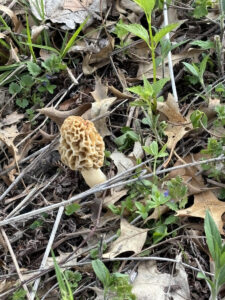
Morels appear like magic.
A surprise morel mushroom sighting was a serendipitous find for Marion. It happened on May Day 2024, in an area of Winding Pathways we’re rewilding. While seeking blooming bluebells and emerging May Apples she spotted the delicious fungus poking through last year’s oak leaves. We’ve since found more. With Cedar Rapids Houby Days just around the corner it looks like a good season for morels.
We own about two acres. Our house, garden, and lawn occupy about half our land. The rest we’re gradually rewilding to its native vegetation. Although we sometimes discover vegetative surprises in our unsprayed lawn, the most delightful new plants appear in our property’s “back 40”.
Nature’s Resiliency
Newly emerging species remind us of nature’s resiliency. A few years ago, a derecho’s 140-mile-an-hour wind knocked down many of our mature trees. Much of our land was shady, but the 40-minute storm transformed it into a sunny landscape. We’ve since noticed a dramatic decline in shade-loving ferns and an increase in sun-loving Wing stem. Other plants are fading and rising as the years go by.
We recently read that archeologists had found 4,000-year-old mullein seeds in an Egyptian tomb. When planted, they sprouted! Lots of native plants may not have the ability to stay viable that long, but they remain down in the soil, perhaps for decades, waiting for the right ecological conditions. Then they rise as if by magic. Other plants can spread their seed widely. Ones that end up in just the right place also sprout seemingly magically.
Pause for Thought
Ecological mysteries give us pause for thought and reasons to marvel at nature’s resiliency. We don’t know if our morels had been in the soil for years or if a spore had landed there more recently. Either way, this spring brought perfect conditions for their growth, and they appeared.
Enjoying Nature’s Abundance
We carefully picked our mushrooms, consulted with an experienced neighbor, and enjoyed them after preparing them and simmering in butter.
We’ll keep watching for others to appear.
Where Do Morels Grow?
Morels live across the country and usually appear in April or May. Hunting them is a popular activity. For information check these websites
Rewilding Winding Pathways
We’re gradually rewilding about an acre of Winding Pathways. Although many believe this simply means “letting nature take its course” we know that’s not feasible today because so many invasive species stress native plants. We manage nature lightly as we rewild our land. Here’s what we do.
- Remove the worst invasive species including Japanese Barberry, Asian Honeysuckle, Multiflora Rose, and Asian Bittersweet. As soon as we spot one, we unleash the lopping shears and chop it off as close to the ground as possible.
- Replaced three areas of lawn with native prairie.
- Carefully use prescribed burns to encourage natives and discourage invasives.
Natural or Native is Not Always Desirable
Two native species belong in our rewilding areas, but we discourage them because of the misery they can cause. We just keep them away from pathways. Here are the culprits:
Poison Ivy: It’s an important and valuable native plant for wildlife. Poison Ivy’s early spring leaves are an almost iridescent red, and they glow bright red in autumn’s fading days. Birds and deer devour the berries. Cottontails love eating the foliage and stems. All good except the itching. Both Marion and Rich are allergic to it and don’t enjoy the awful rashes that result from close encounters. We stay away from poison ivy and don’t cut it but spot-spray those plants growing close to pathways.
Virginia Tickseed: This interesting native doesn’t seem to be used much by wildlife, and it’s rather attractive. Come fall it produces zillions of small burs that are nearly impossible to remove from our clothes. We chop off any we find growing close to paths.
-
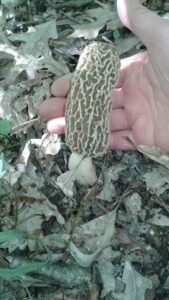
-
Morels’ distinctive shape. Credit Fitzgibbons
-
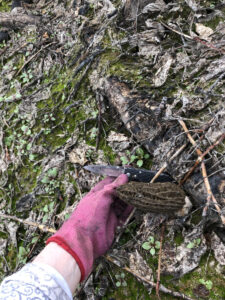
-
Carefully cut or break off a morel. Credit Fitzgibbons
Finding morels was exciting. We’ll likely find plants new to us springing up in our wilder areas. Most won’t be edible like morels, but they are fascinating and are living examples of nature’s resiliency.
by Winding Pathways | May 2, 2024 | (Sub)Urban Homesteading, Garden/Yard, Nature
Field Pussytoes delight us! (And, we plan to encourage them)
Early this spring a lawn care company dropped by and offered to spray our lawn. “We’ll keep the weeds out,” said the enthusiastic young man.
He knocked at the wrong door. We take joy in our lawn’s diversity, and soon after he visited delightful patches of Field Pussytoes sent up stems with their flowers in our lawn. Serendipity.
Field Pussytoes has the intriguing scientific name of Antennaria neglecta. Ours is one of several species of pussytoes that grace unsprayed yards. The word antennaria comes from the plant’s spikey flowers that look like an insect’s antennae. And neglecta? Well, because we are “neglecting” our lawn by not poisoning it, this humble plant thanks us. It needs little care and grows across much of North America.
This native plant thrives in conditions that describe most lawns. It enjoys full sun to partial shade, spreads by rhizomes, and is one of the earliest lawn “weeds” to flower. Its delicate blooms look like a kitten’s feet and toes. Field Pussytoes is pollinated by insects but bypassed by deer and rabbits.
Many years ago, Marion interviewed Lady Bird Johnson at the Lady Bird Johnson Wildflower Center near Austin, Texas. No doubt the former first lady enjoyed blooming pussytoes. The organization she formed has an outstanding website that helps anyone identify and enjoy plants.
Winding Pathways Lawn Management
We don’t neglect our lawn. We encourage native plants that need little care and which enrich the soil. As needed, we run a mower over it, but we’re always on the lookout for unusual plants that volunteer amid the grass. Some are delightful, and a few could be pests, but all are fascinating.
Our lawnmower helps us select the most interesting plants. Many that we might not want, like invasive sweet clover and garlic mustard, tend to grow tall. Our mower never gives them a chance. Field Pussytoes, like violets, hug the ground and escape the mower’s whirling blade. When done blooming, the plants form loose, sage-green mats that need no mowing at all! Gradually they’ve expanded.
One of the fundamentals of classic ecology is that diversity implies stability. Spraying a lawn destroys diversity, creating an unstable monoculture. We escape cost and possible chemical danger by not spraying our lawn. Pussytoes are just one of many fascinating plants that moved in and have spread on their own.
-
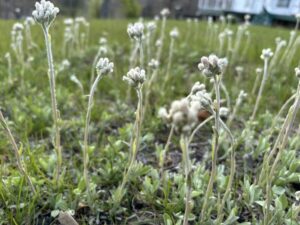
-
Blooms stand up several inches.
-
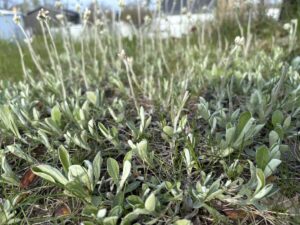
-
Field Pussytoes hug the ground
by Winding Pathways | Apr 25, 2024 | Nature, Reflections/Profiles, Travel/Columns
The steep climb got us huffing and puffing until we crested the hill and looked around. Beneath us was a spacious pond and on the far hillside cattle grazed in the evening’s dwindling light. Oncoming darkness, combined with tired leg muscles, encouraged us to circle back to the historic farmhouse where we overnighted.
It sounds like a Montana adventure, perhaps at the spacious American Prairie, but it isn’t. We were at Iowa’s Whiterock Conservancy, a remarkable landscape just south of the tiny town of Coon Rapids in the west central part of Iowa.
What IS Whiterock Conservancy?
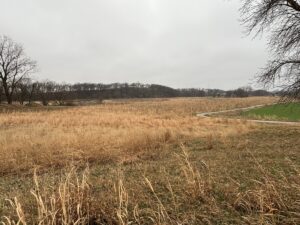
Bike or hike or ride your way along miles of intriguing trails.
Whitrock defies the norm in a state short on places big enough for outdoor enthusiasts who love spaciousness. Winding through its 5,500 acres are about 40 miles of trails that welcome hikers, mountain bikers, equestrians or folks just wishing to walk away from the noise and distractions of modern life. Whiterock is a place to enjoy the quiet and the dark sky of this lightly settled region.
There’s more. Whiterock Conservancy, named for an outcropping rising above a campground, is a testament to the formation of modern agriculture. Roswell Garst farmed the land and enthusiastically promoted hybrid corn. He was a force enabling the land to dramatically increase its production of food.
Entrepreneur, Ambassador, Visionaries
Garst was also an ambassador of sorts and invited his friend, Soviet Premier Nikita Khrushchev, to visit in 1959. The Russian was eager to find ways to expand his country’s food production. For a day the world came to the Garst Farm and Coon Rapids, Iowa. Dignitaries, reporters, and even some possible Soviet Spies were everywhere. The story is that one could tell the “spies” because, in this decidedly farm community, they were the only ones dressed in suits.
The Garst Family was visionary. Rather than sell their land for massive modern agriculture they encouraged the development of the land trust that combines agriculture and outdoor recreation in creative mosaics.
What’s There
After our walk and a picnic dinner, we settled down for the night in the old Garst Farmhouse, marveling at the collection of books, vintage furniture, and artifacts from Khrushchev’s visit inside. Its style was reminiscent of old-time New England homes – low ceilings, a newell post at the end of the stairs, wainscotting, tiled bathrooms, wallpapered ceilings, drapery on the windows, period cookware, and elegant teacups nestled in a corner cupboard. A swing-through door led to the well-equipped kitchen that looked out over a play yard and firepit. We could almost hear Roswell Garst talking up hybrid corn.
How It Came About
The Whiterock Conservancy was created as a nonprofit land trust about 20 years ago. Today it’s a progressive, innovative, and fascinating organization that combines agriculture, ecological restoration, lodging, and outdoor recreation spread over more than 5,000 acres.
We watched the cattle graze, listened as a flock of goats “baaahed” in anticipation of their dinner, drove miles of gravel roads through the property, and walked several trails. Perhaps our favorite was admiring the winter worn prairie grasses and forbs still standing sturdily in a brisk spring wind that rippled the pond’s water.
Things To Do at Whiterock Conservancy
Our short visit just whetted our appetite for the outdoors, and we plan to return. Here are some of many activities welcomed on the land:
-
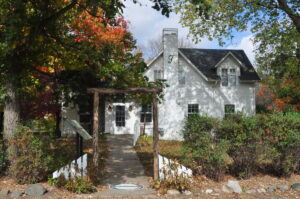
-
Period style farmstead that greeted Nikita Khrushchev. Photo Credit Whiterock Conservancy.
-
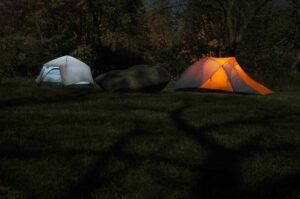
-
Tenting along the river. Photo credit Whiterock Conservancy.
-
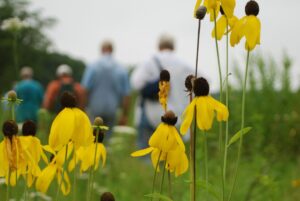
-
The Conservancy hosts a variety of programs. Photo credit Whiterock Conservancy
Camping: Several smallish and rather rustic campgrounds invite overnighters seeking quiet and gorgeous star viewing.
Trails: Well planned and maintained trails wind through hills, prairies, wetlands, and ravines. Hikers, equestrians, and mountain bikers are all welcome.
Home and cabins: Several indoor lodging options range from staying in one of many rooms in the historic farmhouse, to a nearby cottage. There’s even a walk-in cabin.
Activities: Staff and volunteers sponsor periodic programs to help visitors enjoy and appreciate nature and the Conservancy.
Fishing and Hunting: Visitors bearing an Iowa fishing license are welcome to try catching dinner from a dozen ponds scattered about the land. Check with headquarters about bowhunting.
Learn More and Visit!
The Whiterock Conservancy is a nonprofit land trust, funded by donations and grants. A list of fees and information is posted on their website. Donations are suggested for trail users and can be put in convenient boxes near trailheads. We so enjoyed the stay and visit with the staff.
by Winding Pathways | Mar 28, 2024 | Water Resources, Water Resources
(reworked from Iowa’s Wildside Column 8-27-1989)
“When will they ever learn…?” the refrain from Pete Seeger’s song circled in my mind as I reviewed columns, I wrote for the Cedar Rapids Gazette. One stood out. Iowa’s rivers and their then deteriorating condition.
Old Issue Newly Revisited
Over the past 18 months, The Gazette’s environmental writer, Brittney Miller, has addressed Iowa’s poor water quality and its impact on aquatic life.
Ah, yes, when WILL we ever learn? This is a revisit of my column from 30+ years ago.
Iowa is embraced by two of North America’s mightiest rivers – the Missouri and the Mississippi. An interesting network of streams feeds them. The height of land that divides the two drainages follows a barely perceptible rise along a northwest-southeast ridge in the western quarter of the state.
“Let The Rivers Run”
As though Paul Bunyon drew his fingers through Iowa’s geological sandbox, the major tributaries line up in roughly parallel lines flowing southeast to the Mississippi and southwest to the Missouri.
Native Americans and settlers followed these rivers. Later, steamboats, loaded with farm equipment, household goods, and finery pushed their way upstream to then bustling communities. As Iowa’s agricultural economy boomed, grist mills appeared. Farmers exported their grains to Eastern cities along Iowa’s waterways. Emerging railroads and silting waterways hastened the demise of mills. Then, hydropower proved profitable until coal and nuclear power took over.
“Managing” Water

A typical spring scene in the South. Homes under water.
Earliest settlers cussed the Missouri for being too thin to plow and too thick to drink. They couldn’t tolerate its unruly, flood-prone behavior so Congress authorized channeling it with the “Missouri River Stabilization and Navigation Project.” Today, the Missouri is mostly an emasculated drainage ditch – until it rebels and reveals its power, as it has done in recent years.
Consequences
Gone are the oxbows, meanders, belt of trees, and diverse wildlife. Iowans value farmland over natural riparian habitats beneficial to mammals, birds, reptiles, insects, and aquatic life. Oh, and us!
Mighty Mississip

The Mississippi River stretches from Minnesota to the Gulf Coast.
The Mississippi River was dammed and dredged to provide sufficient depth for barge traffic. The dams did create numerous backwaters that support wildlife, but the Great River cannot flush itself out, so it chokes in its own silt. That toxic-laden silt slides downstream poisoning the Gulf and disrupting commercial fisheries there.
What Floodplains Do
Flood plains are areas for all wild and roiling rivers to spend their energy. The dissipated water helps recharge wetlands, and cleanses and naturally replenishes groundwater supplies. Sediment filters out on flood plains, enriching the soil.
Again and Again and Again
As we build and rebuild on flood plains, we keep spending untold dollars trying to conquer the natural elements. As residential, industrial, and agricultural demand for water increases, we rely more heavily on groundwater. That source is stressed, too. The multi-year droughts Iowa has experienced have impacted the aquifers. Lower water tables and tainted water supplies result.
When WILL we learn that our water supplies are important and to treat them respectfully and carefully?
by Winding Pathways | Mar 21, 2024 | Garden/Yard, Garden/Yard, Trees
Bright! Beautiful! Ominous!
As we walked across a New Jersey parking lot last summer an amazingly colorful, and new-to-us, insect fluttered in front of us. It had a gorgeous creamy white and bright red body covered with black spots.
Identifying it was easy and ominous. It was a Spotted Lanternfly. First found in Pennsylvania in 2014 it likely came to the United States from its native China as a hitchhiker in a crate or box.
It may be a pretty bug but its presence is ominous. It feeds on at least 172 different plant species and is spreading rapidly westward from its start close to the Atlantic Ocean.
Feeding off Another Invasive
What’s somewhat ironic about the lanternfly is the insect’s affinity for another Chinese invasive, the Tree of Heaven or Ailanthus. Although the inch-long insect will eat many different plants it prefers this highly aggressive and fast-growing tree.
Important Contact Information
The Iowa Department of Agriculture and Land Stewardship is on the lookout for the Spotted Lanternfly. They ask anyone spotting one in Iowa to report it by calling:
l (515)725-1470 or logging onto their website at IowaAgriculture.gov.
How To Reduce the Invasion
A key to reducing this insect’s abundance may be reducing Ailanthus tree numbers. This invasive tree thrives in urban and rural areas, often forming large groves. It displaces native trees, has little commercial value, and now harbors an introduced insect pest.
Winding Pathways encourages anyone with an Ailanthus in their yard to remove it, convert it to firewood if you can, and replace it with a native tree species. Remember, report any Spotted Lanternflies you spot.
-
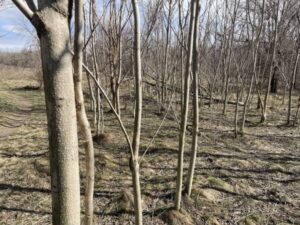
-
Grove of young Ailanthus.
-
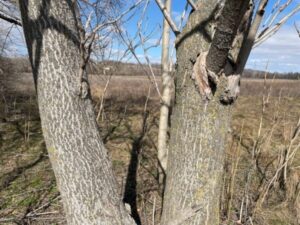
-
Ailanthus trees grow fast.
by Winding Pathways | Feb 29, 2024 | (Sub)Urban Homesteading, Home Improvements, Nature, Trees
Knot Just Lumber
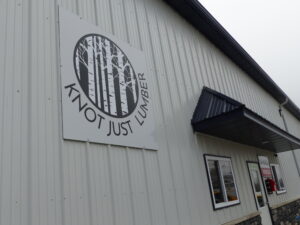
A local store
When driving through Hiawatha, Iowa, recently, a nondescript sign caught our eye. Posted on what looked like a warehouse the sign said, KNOT JUST LUMBER. We had to check it out and soon entered the ultimate wood candy store.
Leaning upright were immense slabs of white and red oak, walnut, cherry, and mulberry destined to become gorgeous tables. Nearby were smaller boards of at least a dozen tree species. Most were cut from native Iowa trees, but some racks held exotic wood from foreign lands. Purpleheart caught our eyes. It comes from trees that grow in Central and South America. When first cut the wood is dull grayish but within a few days, it transforms into an eggplant purple color.
Local Connections
We returned to visit Nic Carter, who co-owns the store with his sister, Caris. The family is from Alburnett and Nic was an active 4-H member dabbling in woods making jewelry boxes for art shows. After stints as a woodworker and home builder Nic, and his family opened Knot Just Lumber in September 2022. He and his sister decided to open the store because, “The area has no local woodworking place, so, I started one here,” he explained.
His father and son help run this family-owned and operated business located just north of Cedar Rapids. We enjoyed an in-person tour, which is augmented by their website and includes a virtual walk-through.
Knot Just Lumber caters to hobbyists, commercial customers, and families. We have visited several times and enjoyed chatting with individual customers and couples, and watched kids touch and smell the smooth, fragrant wood. The company buys trees from wood brokers. Most originate from trees in southern Iowa. The company mills wood into various-sized boards and turning rounds, dries it in an onsite kiln, surface planes, and sands most boards.
Wood is Special
Wood is special. We’ve noticed that in many brand-new houses doors, window frames, and floors are crafted from composite materials and plastic.
Nothing seems natural. In contrast, our 1947-era house has floors of Douglas Fir and White Oak with our furniture crafted from solid oak, pine, walnut, and cedar. Different woods make our home feel closer to nature while gracing us with the individual vibrant colors, textures, and grain patterns of each species. The woods connect us to woodworkers, friends, and craftspeople from bygone and current eras.
Commercial Lumber
Commercial lumber is usually cut from the straightest and most uniform trees. Buy it from a large commercial outlet and it’s attractive and easy to work but lacks the character implanted in wood by knots and irregular growth. In contrast, every wood slab we saw at Knot Just Lumber showed the individuality and character of the tree that created it. “Some of the most interesting wood comes from trees that grew in urban areas where their branches spread widely. It helps give the wood wonderful character and beautiful grain,” said Nic.
Unfortunately, every year millions of trees, many growing in towns, are felled after they die. Beautiful wood inside the bark is frequently hauled to a landfill, ground into shavings, or cut for firewood. Knot Just Lumber converts old veteran trees into lumber destined to be crafted into furniture that endures for generations. The company even saves sawdust and compresses it into briquettes to feed a wood stove or campfire. We bought some and found that they work wonderfully. We appreciated Nic’s caution that they do burn hot, so we use them sparingly. We are excited to use them with our occasional campfires out back.
-
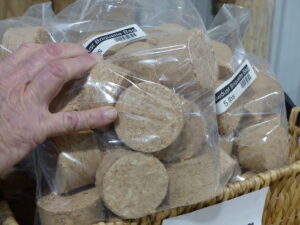
-
Value added and no waste.
-
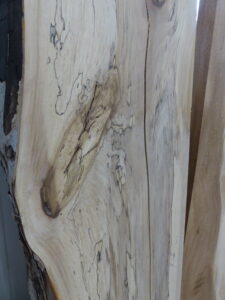
-
Fungi-laced wood
A Way to Add Character to a Room
The materials from our recent downstairs bathroom renovation are mostly manmade. That’s understandable, as the surfaces need to be easily cleaned and resist moisture. But the room needed the character of wood. So, we bought an oak board from Knot Just Lumber to cover a small area of plaster. It adds the warmth of nature to an otherwise utilitarian space.
Hidden Gems

Fusing old and new technology.
Knot Just Lumber is a local store we found by accident. The staff consult, have working spaces and classes for customers and specialize in epoxy with the wood to create gorgeous pieces for homes. Their prices are reasonable, especially compared to national stores or online sources. Similar local stores are scattered across the country. Finding them can be tricky but hobbyist woodworkers know where they are and anyone can Google hardwood lumber and they might learn of a nearby place to buy gorgeous local wood.
Resources
One of our favorite resources to learn the diverse characteristics of dozens of different species of native and exotic woods is the book WOOD! Identifying and Using Hundreds of Woods Worldwide, by Eric Meier.
-
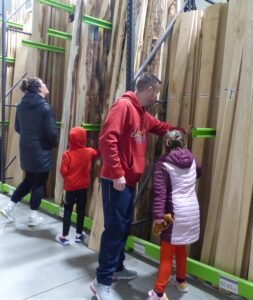
-
Families taking in the lumber.
-
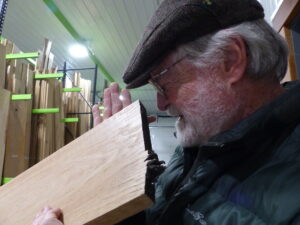
-
Assessing lumber.
-
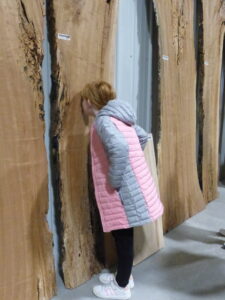
-
wood has a characteristic smell.




















